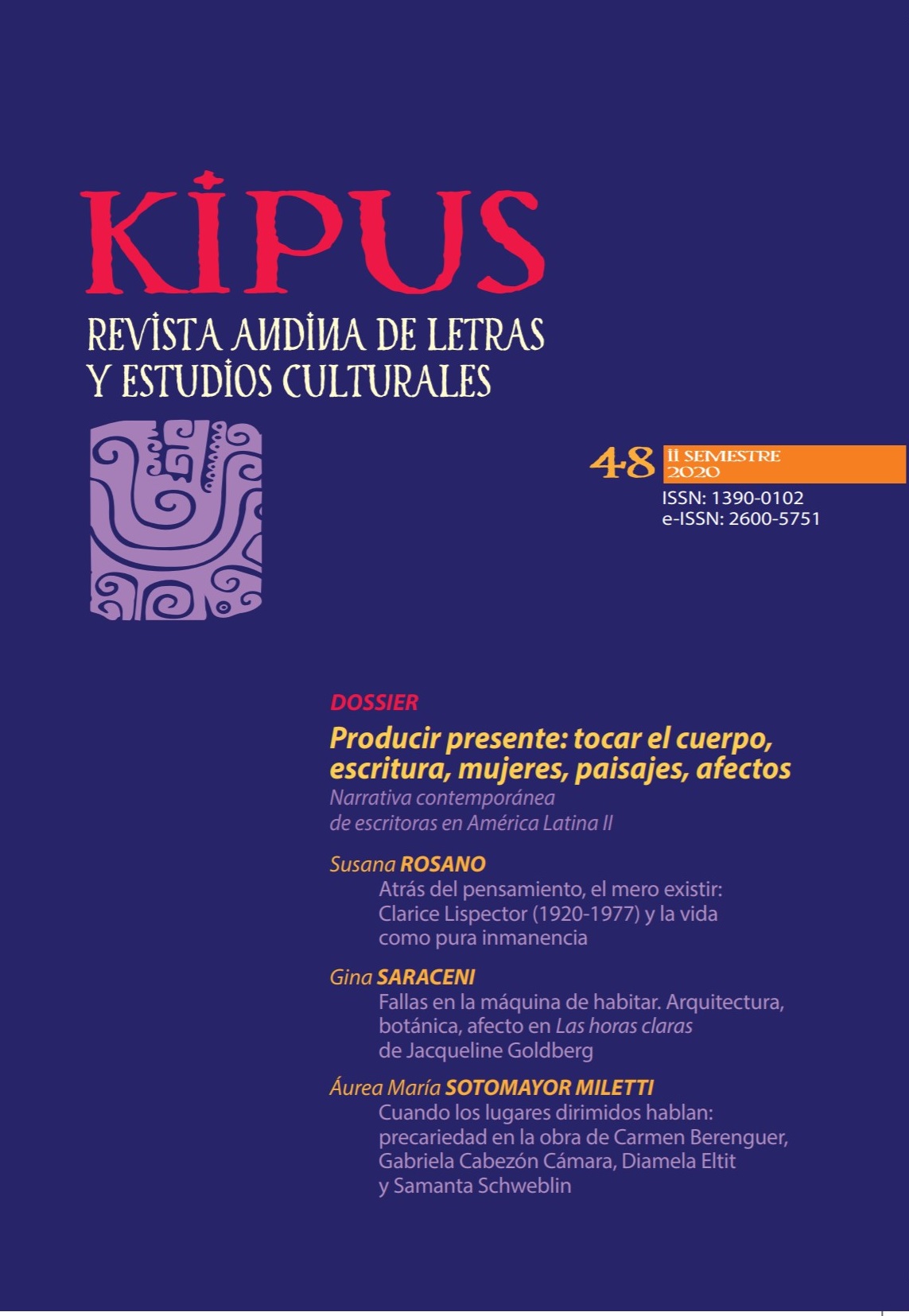Flaws in the Living Machine. Architecture, Botany and Affect in Las horas claras by Jacqueline Goldberg
DOI:
https://doi.org/10.32719/13900102.2020.48.3Keywords:
Jacqueline Golberg, Venezuelan novel, living machine, architecture, modernity, women, family household, affects, becoming-vegetablesAbstract
The purpose of this article is to read Las horas claras (2013) by Jacqueline Goldberg as a means to reveal the ways that this novel, through its “trans-gender” condition, intervenes in official history and proposes a poetics of non-belonging based on the gesture of cracking the topos of the house as a common space of human dwelling. This is also perceived as a form of intervening in literary dwelling by decentering its limits towards other experiences and knowledges such as architecture, botany and culinary. For Goldberg, narrating the life of a French woman in the first half of the 20th century, entails thinking of existence as an inedible fungus, as a green grapefruit that intoxicates and provokes death. In this way, her writing breaks down the hierarchy between human and non-human life to show how the living also expresses negative affects that operate to destroy
Downloads
References
Agamben, Giorgio. 2007. “La inmanencia absoluta”. En Ensayos sobre biopolítica. Excesos de vida, compilado por Gabriel Giorgi y Fermín Rodríguez, 59-92. Buenos Aires: Paidós.
Andermann, Jens. 2011. “Tesis de la metamorfosis”. Boletín (Centro de Estudios de Teoría y Crítica Literaria). Diciembre. 16. https://www.lopezlabourdette.com/pdf/andermannTesis.PDF.
Beasley-Murray, Jon. 2015. “Biopolítica bolivariana”. En La política encarnada. Biopolítica y cultura en la Venezuela bolivariana, editado por Luis Duno, 385-97. Caracas: Editorial Equinoccio.
Coccia, Emanuele. 2017. La vida de las plantas. Una metafísica de la mixtura. Buenos Aires: Miño y Dávila Editores.
Contreras, Sandra. 2018. “La pulsión documental o qué cosa es ser realista”. Revista Ñ. Clarín. 22 de agosto. https://www.clarin.com/revista-enie/literatura/pulsion-documental-cosa-realista_0_Hy6RTXj8m.html.
Deleuze, Gilles, y Félix Guattari. 1994. Mil mesetas. Capitalismo y esquizofrenia. Valencia: Pre-textos.
Escobar, Ticio. 2014. El arte fuera de sí. Asunción: CAV, Museo del Barro.
Garramuño, Florencia. 2015. Mundo en común. Ensayos sobre la inespecificidad del arte. Buenos Aires: Fondo de Cultura Económica.
Giorgi, Gabriel. 2014. Formas comunes. Animalidad, cultura, biopolítica. Buenos Aires: Eterna Cadencia.
Goldberg, Jacqueline. 2007. Verbos predadores. Caracas: Editorial Equinoccio/Universidad Simón Bolívar.
–––. 2013. Las horas claras. Caracas: Sociedad de Amigos de la Cultura Urbana.
–––. “Jacqueline Goldberg y Las horas claras”. https://www.youtube.com/watch?v=fJRjJRyzQAM&t=1092s.
–––. Las horas claras. Blog. http://las-horas-claras.blogspot.com/.
Gomes, Miguel. 2017. El desengaño de la modernidad. Cultura y literatura venezolana en los albores del siglo XXI. Caracas: Abediciones / UCAB / Universidad Católica Andrés Bello.
Moraña Mabel. 2012. “Postscríptum. El afecto en la caja de herramientas”. En El lenguaje de las emociones. Afecto y cultura en América Latina, editado por Mabel Moraña e Ignacio Sánchez Prado, 313-38. Madrid-Frankfurt: Iberoamericana / Vervuert.
Nascimento, Evando. 2016. “Para un concepto de literatura en el siglo XXI: expansiones, heteronomías, desdoblamientos”. En El lugar de la literatura en el siglo XX, editado por Juan Pablo Hormazábal, Josefina Rodríguez y Nicolás Vicente, 47-88. Santiago de Chile: Ediciones Universitarias de Valparaíso, colección Dársena Estudios.
Ocampo, Victoria. 1982. Autobiografía IV. Viraje. Buenos Aires: Sur.
Payares, Gabriel. 2014. “Jacqueline Goldberg: la casa es lo único que nos queda”. PRODAVINCI. 13 de agosto. http://historico.prodavinci.com/blogs/jacqueline-goldberg-la-casa-es-lo-unico-que-nos-queda-por-gabriel-payares/.
Pogue Harrison, Robert. 2017. Giardini. Riflessioni sulla condizione umana. Roma: Fazi Editore.
Simmel, George. 2002. “Las ruinas”. En Sobre la aventura, 181-93. Barcelona: Ediciones.
Speranza, Graciela. 2012. Atlas portátil de América Latina. Arte y ficciones errantes. Barcelona: Anagrama.
Tsin, Anna. “Cómo amar a un hongo”. https://elmalpensante.com/articulo/3519/como_amar_a_un_hongo.
Downloads
Published
How to Cite
Issue
Section
License

This work is licensed under a Creative Commons Attribution-NonCommercial-ShareAlike 4.0 International License.







.png)
